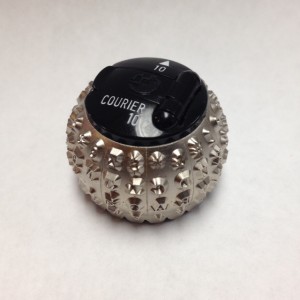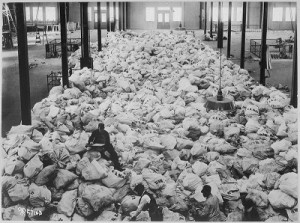Ever wondered who we, in the UMKC Special Collections department, are? Well, we sometimes wonder, too. Behold, our new “Staff Spotlight” feature! What better person to start off with than our very own Director of UMKC Special Collections, Stuart Hinds? Appropriately enough, he is approaching his five year anniversary (October 15) with UMKC so congratulations to Stuart for not only surviving, but thriving! Make sure you embarrass him the next time you see him. I would suggest congratulating him for his five years of service, but feel free to be creative in how you embarrass him.
Against his better judgment, Stuart agreed to sit down with me [blogninja and reclusive librarian, Sandy Rodriguez] to answer a few serious and sarcastic questions.
Rodriguez: What inspired you to become an Archivist?
Hinds: The thrill of handling what I call the “meat” of history – original documents, photographs, maps, recordings, etc.
Rodriguez: What advice would you give someone interested in becoming an Archivist?
Hinds: We don’t do it for the money. And, if you love working with the actual archival “stuff”, don’t go into management – you spend your days talking about and planning for the work rather than actually performing it.
Rodriguez: Oh, so I should probably warn you that I’m going to ask you some really important and personal questions in this interview. Here’s the first one. What is your favorite color?
Hinds: Green.
Rodriguez: Fascinating choice.
Hinds: [stares blankly at Rodriguez]
Rodriguez: What do you like best about working at UMKC?
Hinds: The energy and enthusiasm of the students and faculty who regularly use our collections.
Rodriguez: Good answer. I sometimes forget about them.
Rodriguez: How many fingers am I holding up?
Hinds: Three.
Rodriguez: That’s a German three to be more specific, but I see your eyesight is still intact. That’s probably really important for your line of work.
Hinds: A little bit.
Rodriguez: We hear you have an interesting collection of outdated library technology. Tell us about some of your favorite items in the collection?
Hinds: The various IBM typewriter “globes” – each of which provided a different typeface – bring to mind an era long gone. The 2nd edition of the ALA Rules for Filing Catalog Cards is absolutely charming. The “postage stamp affixer” – a stamping machine that spat out moistened stamps – is a fascinating piece of completely obsolete technology. But my favorite is the small faded typewritten sign bordered with yellowed cellophane tape that reads “THIS CLOSET CONTAINS LIBRARY MATERIALS. THE LIBRARIAN HAS A KEY. ALL OTHERS STAY OUT!”. Talk about “open access”…
Rodriguez: [laughs] That is fantastic.
Rodriguez: What is your favorite comfort food?
Hinds: Kraft macaroni and cheese with hot dogs.
Rodriguez: Wow, really?!
Hinds: It’s so good. A salt-fest. I am from the Ozarks.
Rodriguez: If you could take one item in the archive home with you, what would it be?
Hinds: I wouldn’t want to take anything home – no one would be able to see it.
Rodriguez: [rolls eyes] Such a typical “good archivist” thing to say.
Rodriguez: Have any guilty pleasures you’re willing to share with us?
Hinds: Taking too much pleasure in watching The Real Housewives, specifically OC, Beverly Hills, Atlanta. They’re all crazy.
Rodriguez: We finally have something in common. Don’t tell anyone. Oh, crap.
Rodriguez: What is something most people don’t know about you?
Hinds: I know far, far too much about The Lawrence Welk Show. I still watch it religiously each week, and a favorite pastime is to guess the year of the show based on cast members and fashions.
Rodriguez: [stares blankly at Hinds]
Rodriguez: Okay, well, as with any well-constructed interview, we saved the most important question for last. [dramatic pause] Boxers or briefs?
Hinds: [laughs] Boxer-briefs.
Rodriguez: [awkward silence] Well-played, sir. Okay, well, thank you for taking the time to interview!
Hinds: You’re very welcome.





